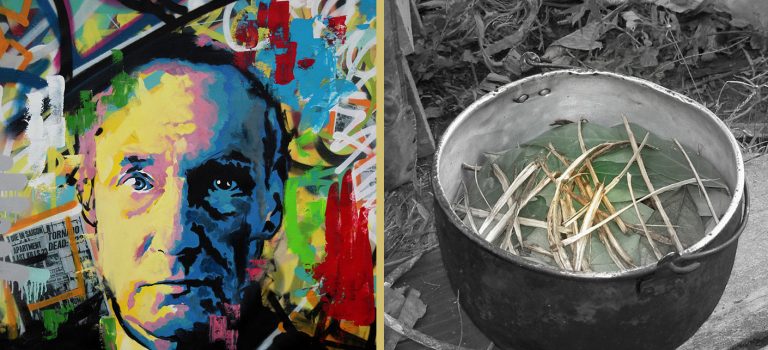One of the most disconcerting effects of ayahuasca is that it sometimes seems to allow us to “read” other people’s minds or “transmit” ideas without the need to speak. The description of this phenomenon is not anecdotal but very frequent in the scientific literature, to the point that the active principle of ayahuasca (Banisteriopsis caapi) was baptised “telepathine” back in 1915.
The term was coined by the famous Colombian botanist Rafael Zerda Bayón, and appeared for the first time in his paper ‘Informes sobre mi excursión científica en las regiones colombianas de Caquetá, Bogotá, Colombia’ (Reports on my scientific excursion in the Colombian regions of Caquetá, Bogotá, Colombia). However, the error persists of attributing the discovery to the American ethnobotanist Richard Evans Schultes, who began to use the term “telepathine” during the 1940s. Since Schultes studied yagé in Colombia, it is very likely that he was aware of Zerda Bayón’s studies and writings three decades earlier.
But it was neither Bayón nor Schultes who popularised the telepathic abilities of ayahuasca but the novelist and drug addict William Burroughs, who in his ‘The Yage Letters’ to his friend, the poet Allen Ginsberg, wrote the following:
“A Colombian scientist isolated a substance from yagé which he called telepathine. I know from my own experience that telepathy is a fact. I have not the slightest interest in proving telepathy to anyone or anything. I want to have the useful knowledge of telepathy”.
The book was published in 1963 (although it was written ten years earlier, in 1953) and aroused great interest in ayahuasca in North America, giving the starting signal for the ayahuasca tourism that is so common in the Amazon region today.
Telepathine, a personal experience
Like Burroughs, many of us who have been touched by the ayahuasca angel can affirm that telepathy is a fact. I had the certainty exactly one year ago, during the summer solstice of 2019. It was in Madrid, at a ceremony of my dear Nak, then president of the Plantaforma. Rita and I went together, once again, and spent a good part of the trip in each other’s arms, our heads in contact, and we were able to have telepathic “conversations” without uttering a word or even looking at each other. I felt like his brain was mine and I could directly access his thoughts.
-Don’t worry, I’m fine.
-But you’re making me worry by telling me that.
The next day we confirmed these and other “words” by word of mouth. Rita had a hard time that night and tried to reassure me, but I knew – I could see – that she was having a hard time.
Harmina = telepathine
Unfortunately, the evocative name “telepathine” is no longer used (the last references are in the writings of Claudio Naranjo in one of his last books ‘Ayahuasca’, which is also written half a century ago, during the 50s and 60s). The reason is that telepathine is exactly the same molecule as ‘Harmine’, a beta-carboline described a few years earlier and which takes its name from harmel, the common name of the Syrian rue (Peganum harmala), a plant widely used in the traditional pharmacopoeia of Arab countries and which some call the “European ayahuasca”.
*”The first among us who undertook its study was Dr. Rafael Zerda Bayón, of pleasant memory, a true man of science, who spent most of his life observing nature with the idea and conviction of one day extracting from it some of its hidden secrets.
He made a famous scientific expedition to Caquetá and Putumayo with the purpose, among many others, of studying more closely and in detail the active principle of this plant, which was the object of a profound and conscientious work, by means of which he managed to suppose, after multiple experiments without managing to isolate it, that this plant must contain as its active principle an alkaloid, which he baptised with the name of telepathine because of the very particular and curious effects produced by the ingestion of its preparations.
In honour of the memory of this illustrious scholar, the alkaloid which we have isolated, and which he supposed to exist, should retain the name of telepathine”.
‘Study on the active principle of yagé’, Guillermo Fishcher Cárdenas.
Did you like the article? Buy us a coffee or become a member of the Plantaforma so that we can continue writing many more.
